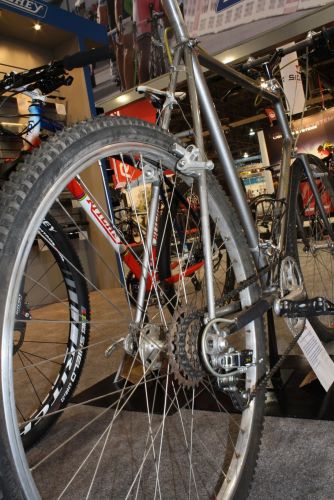Once viewed as the less-extreme alternative to the 29er, perhaps suitable for longer travel and/or smaller frame sizes, 650B is quickly emerging as the staple size of mountain bikes of the near future. At Taichung Bike Week earlier this month, many in the industry seemed a bit shocked at how fast the change was happening at factories across Asia.
With the inventory and technical decisions working out of the way, now it’s time for the marketing to retailers and consumers, and here the concept couldn't be simpler.
Many an industry has built marketing campaigns around more subtle improvements
All else being equal, a larger wheel size should offer faster/easier rolling and better stability. It's why your big brother's bike was faster than yours. It's a concept easily understood by most folks, and many an industry has built marketing campaigns around more subtle improvements. The ski industry, for example, seems to re-invent its boards every five years or so. Whether it's the cap ski, the shape ski, twin tips or the rocker ski, the morning TV shows and outdoor magazines gush over the new equipment that is going to finally make skiing a joy for newbies. By comparison, a bigger wheel on mountain bikes is earth shaking.
Non-enthusiasts might grasp the idea quicker than veterans, who get bogged down in technical "what-about’s” and the inevitable “we-don't-need’s."
The wheel size shift is likely not as big an improvement to the mountain bike riding experience as was the disc brake or suspension, but the wheel size change is happening much more quickly and smoothly. It took a few seasons before discs were reliable improvements to direct-pull brakes for most riders, and early suspension forks were leaky, heavy, sticky and flexible — high prices to pay for their meager travel. By comparison, the switch to 650B is almost seamless and is happening quicker than anyone predicted a few months ago (and a few early adopters like Jamis deserve credit here for being ahead of the curve).
But it's not clear the industry is gearing up to tell potential riders about the change. Some downplay it. "A year from now, we're not going to be talking about 650B or 27.5," said one product manager at Taichung Bike Week. "It will just be what a mountain bike is." His point was partly that focusing on the nomenclature (or worse: the measurement) risks confusing the marketplace. Better to promote other wonderful features of mountain biking and his company's bikes in particular, right?
But why avoid marketing the hell out of a shift that, while not as big as the wheel's invention, offers a very real opportunity to inspire upgrades and new participants?
The answer of course is competition and lack of cooperation in the bike market. No one wants to market a dimensional change that can be adopted by their competition so easily.
The most obvious evidence is the lack of agreement on a name for the new size (which of course is not a new size at all, as Tom Ritchey will point out. Ritchey first used the already established bike tire size on a mountain bike in the 1980s). Ritchey himself still likes to call the dimension 650B, we're told. But other folks within his company prefer 27.5. At Taichung Bike Week, the company was non-partisan, showing a wheel labeled "650B" mounted with a tire labeled "27.5." Cannondale even refers to the wheel size as "27 inch."
There's still time to get it straight. Afterall, most riders, even enthusiasts, are blissfully unaware of the concept and would have to search high and low to find a bike with the new-sized wheels in a U.S. store. One imagines with dismay how a consumer's questions about the size would be received in most bikes shops this fall.
I’ll stay agnostic on the question of the proper nomenclature for the wheel diameter under discussion here. But I hope the industry can settle on a name quickly and then yell it from the roof tops. Bigger wheels roll better, no matter what letters are written on them.


